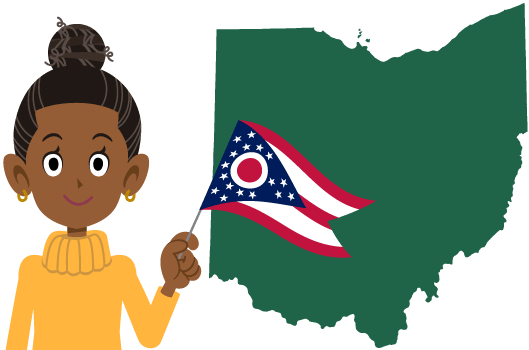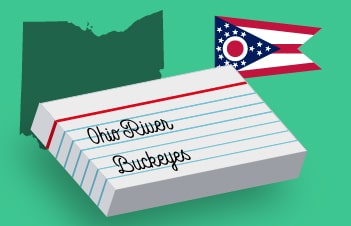The state of Ohio is a state of many firsts; did you know that the first traffic light was used in Cincinnati in 1914? Or that the famous inventor Thomas Edison was actually born in Milan, Ohio? There has been a debate for years over whether Ohio or North Carolina should be considered the birthplace of aviation. It has recently been decided that Ohio is the true birthplace of aviation since the Wright brothers were born in the state!
With Time4Learning’s series of United States unit study supplements you can delve into Ohio facts and information, geography, educational activities, field trip ideas and more. You can also download our list of PreK-12 interactive lessons that align with your study of interesting facts about Ohio.
Ohio Fast Facts
| Became a State: |
March 1, 1803 |
|---|---|
| Order it Joined the Union: |
17th state |
| State Capital: |
Columbus |
| State Abbreviation: |
OH |
| Border States: |
|
| State Flag: |  |
| State Song: | Beautiful Ohio |
| State Flower: |
Scarlet carnation |
| State Nickname: |
Birthplace of Aviation, The Buckeye State |
| State Motto: |
“With God, all things are possible” |
| Notable Ohioans: |
|
Historical Facts About Ohio
Ohio has been inhabited for thousands of years, originally by the Mound Building Cultures such as the Hopewell and Adena peoples. As time went on, different cultures inhabited the land, and in the 1600s, the Iroquois Indians pushed out the remaining peoples of Ohio to hunt for beaver furs. As the land became more known, Europeans visited and brought diseases, which wiped out many of the Iroquois.
The first European, Frenchman Robert de La Salle, arrived in Ohio in 1669. He claimed the land for France and more Europeans moved to Ohio to sell furs, and several forts were created in the process. Fort Miami was created in 1680 and Fort Sandusky was created in 1750. However, after the forts were established, the British came into Ohio and began to compete with the French.
With the British coming to Ohio, the French and Indian war began, leading to the British taking control of Ohio in 1763. Once the Revolutionary War ended, Ohio became a part of the Northwest Territory and more settlers came to Ohio. In 1803, Ohio became the 17th state to enter the Union. After becoming a state, Ohio spent much of the 1800s engaging in war as the remaining Native Americans rebelled and, later, as the War of 1812 commenced.
As history continued, Ohio fought with the Union during the Civil War and was considered a “free state” since it outlawed slavery. Ohio was home to many of the senior military leaders during the war. In fact, seven presidents of the United States have been from Ohio! The only state home to more presidents has been Virginia thus far – perhaps more of our future presidents will be from Ohio, too.
In the timeline below, you can learn more about Ohio history facts and enhance your children’s online learning experience:
1000 A.D.
Hopewell and Adena peoples inhabit the land that will become Ohio
1600s
Iroquois Indians inhabit Ohio and begin to use the land to hunt for beaver furs
1669
French explorer Robert de La Salle finds and claims Ohio for the French
1763
The British gain control of Ohio after the French and Indian war, with George Washington fighting with the British in Ohio at the Battle of Fort Necessity
1782
96 Lenape Indians are killed by an American militia, which was called the Gnadenhutten Massacre
1783
Ohio becomes a territory of the United States once they win the Revolutionary War
1787
Ohio becomes part of the Northwest Territory, which also includes Illinois, Indiana, Michigan, Wisconsin, and Minnesota
1788
The first permanent settlement of Ohio is created in Marietta
1794
The Battle of Fallen Timbers is fought between the Native Americans in Ohio and the United States, with the United States being the winner
1803
Ohio becomes the 17th state to enter the Union
1812
Ohio is one of the battlegrounds used during the War of 1812
1816
Columbus becomes the official capital of Ohio
1837
Procter & Gamble, a multinational corporation which makes cleaning supplies, is established in Cincinnati, Ohio
1898
The Goodyear Tire company is created in Akron, Ohio
1955
The Ohio Turnpike is completed and opens
1995
The Rock ‘n’ Roll Hall of Fame museum opens in Cleveland, Ohio
Bring history and geography to life with Time4Learning’s interactive online social studies curriculum for grades 2-12.
Ohio Geography
Can your homeschooler locate Ohio on this printable map of the United States? To enhance your unit study supplement, explore a map of the state, then download our printable Ohio map below and mark it with your child.
Ohio is quite a fertile state that is home to all sorts of plant and animal life. Wildflowers can be found all over the state, including species such as phlox, trillium, aster, and wild lily. Plenty of wildlife, including black bears, bobcats, beavers, wild turkeys, black racer snakes, and chorus frogs, can be found all over the state. There are over 350 species of birds found in Ohio!
Because of the state’s location directly south from Lake Erie, Ohio receives quite a bit of snowfall each year, with its capital receiving about 22 inches of snow per year. Cleveland, which is about 125 miles northeast of Columbus, gets 66 inches of snow per year! This is because Cleveland is located directly on Lake Erie, whereas Columbus is near the middle of the state, and their locations make quite a difference!
Here are some facts you and your homeschooler may want to note about Ohio’s geography and unique features.
- The name “Ohio” came from the Iroquois Indians’ word “oyo,” which means “great river.” It was given this name due to the Ohio River, which is where the Iroquois were located.
- The state was given its nickname “The Buckeye State” due to the Buckeye trees in Ohio, named because the nuts of the tree look like a deer’s eye.
- The Ohio and Erie Canal was created in the 1800s to connect Lake Erie and the Ohio River, which greatly increased the trade activity in the region.
- The Appalachian Plateau covers most of the eastern region of the state, and is Ohio’s largest region.
- Ohio is considered to be the start of the corn-belt that exists in the midwest; the area that corn growth begins is called the Till Plains and is in the west and middle of the state.
- The highest point in Ohio is only 1,550 feet high and is called Campbell Hill. It is only about 60 miles northwest of the capital, Columbus, and is not high enough to be considered a mountain.
- A five-mile crater exists in the southern area of Ohio, called the Serpent Mound Crater. This crater is suspected to be caused by a meteorite crashing into Ohio millions of years ago. The crater spans three counties, including Adams, Highland, and Pike County.
- Ohio is known for its great source of halite, a rock salt, which is mined from under Lake Erie. The state produces over five million tons of halite per year.
Ohio State Map
Download our FREE Ohio state map printable. Use it as a coloring page or use it to plot the state’s geographical features.
Activities for Children in Ohio
Whether you homeschool in the state of Ohio, or are just visiting, below is a list of field trip ideas that will help supplement the Ohio facts unit study.
- Great Lakes Science Center (Columbus) – The Great Lakes Science Center is one of the best locations in the state for fun and interactive STEM Education. For those curious about the natural environment of the great lakes region, this is the place for you! This science center is also home to the NASA Glenn Visitor Center, one of 11 in the country. There are also homeschool programs offered October through February.
- Rock & Roll Hall of Fame (Cleveland) – For all the rock and roll fans, this hall of fame provides an immersive music experience. This field trip location recognizes and archives the most famous rock and roll musicians, producers, and provides a fun history of the genre.
- Cincinnati Zoo & Botanical Garden (Cincinnati) – Considered one of the best zoos in the country, the Cincinnati Zoo provides for an entire day of fun for all ages. The zoo is also home to several famous animals, such as Fiona the Hippo and Susie the Gorilla, and will be growing in coming years.
- Garst Museum (Greenville) – For history buffs, the Garst Museum is a must-see field trip. With over 300,000 artifacts, this museum offers so much to learn. One of their most exciting exhibits includes the story of Annie Oakley, a young sharpshooter who was born and raised in Ohio!
- MAPS Air Museum (North Canton) – The MAPS Air Museum is an internationally known museum of aviation with plenty to do and see. With constant new exhibits, the museum offers students the chance to explore an airplane hangar and see historic relics, such as the USS Arizona from World War II
Looking for more things to do with your kids in Ohio? Check out this post full of field trip ideas in Ohio!
Ohio Freebies and Deals for Homeschoolers
- Ashland Symphony Orchestra (Ashland) – Offering many free concerts, the Ashland Symphony Orchestra is a great way to get your child interested in music. Make sure to check their website to see which concerts and events are free.
- Ohio Statehouse (Columbus) – For those interested in architecture, history, and politics, this free field trip is for you! Students can tour the Statehouse, Senate Building, and the Atrium. The Atrium is home to the Lincoln Plaque, which signifies when he visited the Ohio Statehouse in 1859.
- Cincinnati Art Museum (Cincinnati) – This museum is always free and offers over 67,000 pieces of artwork over the past 6,000 years from across the world to view! Visitors can wander freely through the museum or join on a free tour led by a docent. Free programs are also offered for children; make sure to check the website before your visit!
- Marblehead Lighthouse State Park (Marblehead) – Known as one of Lake Erie’s most known and photographed landmark, this state park houses the oldest lighthouse on the great lakes. The park, offering scenic areas for picnics, and the museum are free to visit, but to climb the lighthouse is $3 per person over the age of six.
Ohio Learning Games for Children
Now that you have learned these Ohio facts and history, continue the fun with these free learning resources:












